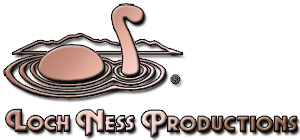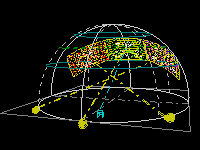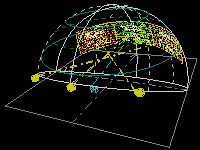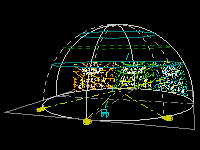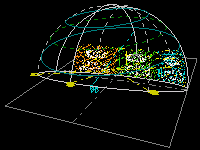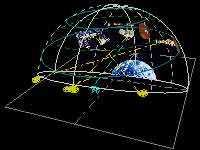| In the production studio: Computer with CD-ROM drive Image processing software Output device |
| In the theater 1. At least three dissolve-pair slide projectors in L-C-R array |
| 2. Dissolving horizon panorama and/or all-sky projector system |
| 3. Planetarium star projector |
| Recommended: Zoom-slew |
| NOT used: Video |
The Voyager Encounters Equipment Requirements
With nearly 300 images to show, The Voyager Encounters is a visually complex show; it requires a well-equipped planetarium theater to present. We've provided this page to help you determine if your planetarium has the necessary equipment to present The Voyager Encounters.
The show soundtrack is recorded on CD, so you'll need a CD player to play the disc, even if it's just to copy the audio to another medium, such as multi-track tape or hard drive.
The show's still images are recorded on data CD, so you'll need the resources (computer, image processing software, output devices) to transform the digital images into whatever form your theater uses to project. For classic (slide-projector-based) planetaria, that will mean making 35mm slides.
1. At least three dissolve-pair slide projectors in Left-Center-Right array
This is a screen format familiar to long-time Loch Ness Productions customers.
Many of the scenes in our shows are illustrated with three images, which are introduced in sequential order: Left, then Center, then Right. After all three are up, they often "wipe" off in the same order.
There are several instances — Jupiter, for example — wherein we build a Left-Center-Right montage, and all three screens dissolve to false-color versions of the same images. A 6-image sequence recreates a "movie" of the Saturn ring spokes, which calls for critical alignment.
We say "at least three" dissolve screens, but the more, the merrier. There are several points in the show where you may wish to make a whole-dome montage of images.
A scrim of a Voyager histogram is designed to fit around a dissolve pair screen, so it will need a larger-than-dissolver lens on it.
2. Horizon panorama and/or all-sky projector system
There aren't too many multi-panel images in the show — Voyager didn't land on any planets, so it didn't provide any horizon panoramas. However, we did create a 360° Saturn panorama, from a perspective within the ring plane. So you'll need that calibrated set of projectors which project on the horizon, commonly known as a panorama system. (In the digital age, what may be a 3-panel pan in one theater may be a 2- or 4-panel pan in another, or a pan can be remapped to an all-sky.)
As you know, individual slide frames are in a 3:2 ratio. The other two multi-panel images in the show are in a 9:2 format ratio — what might otherwise be called "3-panel partial pans". These are intended to span approximately 90 degrees.
All this is in addition to the dissolvers, which project up in the sky, of course. They'll handle the bulk of the show's imagery.
Several of the single-frame images are chords of planets and moons, designed for projection on the horizon. Using dedicated projector with an anamorphic or wide-angle lens to stretch the chord images can work well for this purpose too.
3. Planetarium star projector
The Voyager Encounters uses the planetarium star projector primarily for its starfield, when depicting space scenes. When we're not depicting space scenes — quite often, actually — we recommend fading stars out. The starfield shouldn't be generic wallpaper throughout the show.
Pointer cues indicate Canopus and Rigel Kentaurus, guide stars for Voyager's star trackers.
Recommended: Zoom-slew
While non-moving slides can illustrate the scenes, the show will benefit from having Voyager flying, planets zooming, etc. We provide 3 different Voyager craft images, in two sizes each, and expect you to use the ones that look the best in your theater.
NOT used: Video
We use no moving video with the show, intentionally. This is a program designed for the pacing of still imagery. The visual style of the show is non-dynamic slides. To have inserted just one or two video clips would have been very jarring and out-of-context with the remainder of the show. In other words, why would there be only one or two scenes that feature full motion animation, when the rest of the show doesn't have any?
